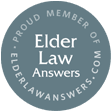Medi-Cal and Medicare Benefits: What's the Difference?
When you are meeting with your elder law attorney near Los Angeles, you’ll undoubtedly discuss Medi-Cal and Medicare. Of course, California law can be confusing when it comes to planning for the future. Even if you research long-term care options on your own, you’re going to run into these programs. To help make sure you understand both Medi-Cal and Medicare, here is everything you need to know.
Medicare
What is Medicare?
Medicare is a federal health insurance program meant for individuals who are at least 65 years old. Individuals who are disabled or going through dialysis may also qualify.
Those on Medicare are required to pay a portion of their medical expenses via deductibles along with small, monthly premiums for non-hospital coverage.
Coverage
There are two main types of Medicare: Part A and Part B.
Medicare Part A is used to help cover care in hospitals, skilled nursing homes, home health care, and hospice care.
Medicare Part B is geared more towards doctor visits, outpatient hospital care, and other medical services.
While there may be some out-of-pocket costs for Part B services, Medicare recipients are not required to pay for services provided under Part A.
There are two additional parts of Medicare coverage that aren’t often discussed. Part C is called the Medical Advantage and works more like a private insurance plan. Part D is used to cover prescription drugs.
Eligibility
Medicare eligibility is rather straightforward. You need to be at least 65, a U.S. citizen or permanent resident and have worked for at least ten years in a Medicare-covered job. There are exceptions for those younger than 65 that have a disability or End-Stage Renal disease.
Medi-Cal
What is Medi-Cal?
Medi-Cal is primarily a Medicaid program in California that provides low-income individuals health coverage. The program helps pay for a variety of medical services for both children and adults. Read more about medi cal planning.
Coverage
In general, Medi-Cal only covers appointments and procedures that are deemed medically necessary. You are also required to work with providers who accept Medi-Cal, so you may not get to see your regular physician. Here are some of the most common uses of Medi-Cal.
- Doctor Visits
- Laboratory tests, including X-Rays
- Hospital and Nursing Home Care
- Home Health Care
- Some prescription drugs
- Prosthetic and orthopedic devices
- Hearing aids
- Medical equipment
- Ambulance services
- Hospice care
- Dental services (through the Denti-Cal program)
Eligibility
Medi-Cal is primarily used for low-income individuals. There are various factors taken into consideration when you apply for one of Medi-Cal’s programs. Most will look at your countable asset level. For an individual, you can have $2,000 in assets or $3,000 if you’re a couple.
Don’t worry, though; not everything you own is considered an asset. Medi-Cal doesn’t look at your primary home, vehicle, household goods, personal belongings, life-insurance policies, or prepaid burial plans and plots.
There are four main programs that fall under Medi-Cal. While the eligibility requirements are similar, there are some slight differences. Learn more about medi-cal planning in Los Angeles.
Supplemental Security Income (SSI)
SSI is available to individuals who are at least 65, blind, or disabled with monthly incomes less than $931.72 for an individual or $1564.14 for a couple, with some exceptions. Meeting these requirements means being fully qualified for Medi-Cal coverage.
Aged & Disabled Federal Poverty Level (A&D FPL)
This program starts with the same eligibility rules for SSI but includes a few other rules. If you’re not eligible for full SSI, this might be a good option. This program requires a monthly income of less than $1,271 for individuals and $1,720 for couples.
Medi-Cal with a Share of Cost (SOC)
For those with higher incomes than allowed by SSI or A&D FPL, but meet the asset requirements, there is another option.
The SOC program operates much like an insurance deductible plan. You would be responsible for paying a certain amount in any month you incur medical costs. Once your deductible is met for the month, you don’t have to pay any more until the next month.
Individuals are responsible for $600 of shared cost per month, while couples will pay up to $934.
250% California Working Disabled Program (CWD)
This program helps those who make enough to not qualify for other programs, who are actively working, and who are disabled.
To qualify, applicants must meet the medical requirements for social security, nearing at least a part-time income, have assets worth less than $2,000/$3,000, and earn less than 250% of the federal poverty level.
CWD works more like a monthly premium based on your income.
The Biggest Differences Between Medicare and Medi-Cal
The most significant difference between these two programs is that Medi-Cal is provided through private companies through contracts with Medicare.
Medicare is run entirely by the U.S. government and is available throughout the country. Medi-Cal is only available for California residents.
While you can qualify for both programs, most services will go through Medicare first before being paid for by Medi-Cal.
Planning is Key
Even with a foundational understanding of Medicare and Medi-Cal, things can get confusing. Because Medi-Cal is an assistance program based on need, it’s crucial to plan so that you don’t exhaust all of your funds too early or in order to qualify.
One tactic that many try is to transfer assets out of their name to meet the Medi-Cal requirements. Recent federal laws, however, require a five-year waiting period after assets are transferred before you can apply for Medi-Cal for long-term care. It’s not as easy as making a quick transaction and then all of a sudden becoming eligible for care. Not having a plan could mean having to wait beyond your need. Check for medi-cal planning attorney in Orange County CA.
A Los Angeles Elder Law Attorney Can Help
Due to the complications involved with Medi-Cal and Medicare, you don’t want to risk going it alone. A misplanned approach could result in a delay of care or being deemed ineligible for these vital programs.
An elder law lawyer isn’t just an expert on federal and local programs but knows how to create a plan that can maximize your benefits without risking the wait. Whether you’re planning for yourself or someone you love, it’s never too early to start thinking about protecting the future.











